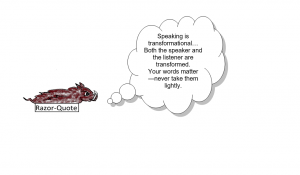40 Student Engagement: Tips For Teachers
Lynn Meade

Cat’s cover their material, I teach mine.
Shane Robinson’s presentation
on Student Engagement at Teaching Camp
Chances are if you are here, you care about teaching. We have that in common. I believe that teaching is one of the highest privileges and I am passionate about engaging students. Zepke and Leach in Active Learning in Higher Education define student engagement as “Students’ cognitive investment in, active participation in, and emotional commitment to their learning.” As teachers, it is our challenge to help students on their education journey. It is our job to engage them and help them find ways to be active participants in their learning. This chapter is my collection of the best student engagement practices gathered through the years and my hope is that you will find something here that you can adapt to your class.
BEFORE CLASS STARTS
The first contact is often an email with a syllabus attached. After reading your email, students decide if they like you and if they like the class. You can help things along by sending out a welcome letter that sets a positive tone and tells them how your course will apply to their lives.
Here are Examples of Welcome Emails from My Classes
Welcome to Advanced Public Speaking. My name is Dr. Lynn Meade and I will be your guide through this incredible journey. I’m looking forward to meeting each of you and learning about your story, your convictions, and your passions. I will do my best to challenge you and guide you as you develop critical public speaking skills. Most students are surprised that this class not only helps them with speaking skills but also with life skills—most importantly, critical thinking. In addition, many students tell me that after taking this class they have higher self-confidence and self-esteem.
Prepare yourself. I don’t do a lot of the talking—I let you do it. You learn public speaking best by getting up in front of people and talking. I will make sure that you have a lot of opportunities to do just that in this class! We’ll start off the first day with a class overview and then it is on to the good stuff. Let’s start to have some fun!
Welcome to Nonverbal Communication. This is going to be a great semester. I know that after having this class, you will never see the world the same again. Of all the classes that I teach, this one seems to stick with students in some of the most significant ways. I have students message me years after they graduate and tell me how this material has helped them in their careers. I’ve even had some students tell me that they used what they learned from this class to get a job over more qualified candidates.
No matter what your major and no matter what you want to do in life, the material in this class can be used to make you better– better at relationships, better at your job, better with daily communication. This is more than just a class; this is an adventure.
CHECK THE EMOTIONAL TONE OF YOUR SYLLABUS
Pick up your syllabus, remember what it was like to be a student, and begin reading. What do you think of this teacher? Will you like this class?
Here are a few ways teachers set the tone.
- Psychological Scientist Jennifer Veilleux makes her syllabus look like a party invitation.
- Psychology teacher and technology expert, Katherine Zawisza, formats her syllabus using sway. ( Take a look here to see what she presents to students. https://sway.office.com/lxvY0XIxkMc4BllB?ref=Link )
- At the University of Arkansas teaching camp, one teacher said they put “easter eggs” in the syllabus for students to catch.
- I include positive quotes related to the class topic. (The University of Arkansas mascot is the razorback so I drew a little razorback to go with the quotes.)

As you read each of these statements, ask yourself what do you think of the teacher and what do you think of the class?
“Email is generally the best way to contact me. Please make sure to put the nature of your email on the SUBJECT line. In your email put your full name and your student’s ID. I will not recognize you by your email address. If there is nothing on the subject line, I will not open the email.”
“My job in this course is not to tell you what to think but to help you think better on your own. Keep in mind that “for every complex problem, there is an answer that is clear, simple, and wrong.” By stirring up the waters of easy and taken-for-granted explanations and showing how our world is but one of many possible socially constructed realities, sociology often makes what is familiar seem strange, and what is strange seem more familiar. In so doing, sociology helps us to see the world more clearly and with greater empathy for others. I hope you enjoy the journey, and I am honored to be your guide this quarter.”
When considering the emotional tone of your emails and your syllabus. Ask yourself these questions:
- What is the tone of your syllabus? angry? punitive? friendly? open?
- Does your syllabus read like a legal contract full of rules and punishments?
- Do your emails feel like they are from a teacher who cares?
- Do you use-friendly and inviting language. Do you use “you” instead of “students?” For example, “You will learn to discover” as opposed to “students will discover.”
Setting the Emotional Tone
One of the ways that I set the tone on my syllabus is to include my teaching philosophy :
My Teaching Philosophy
Why I Do What I Do and Why it Should Matter to You
- I believe that teaching you is one of my greatest adventures. I LOVE to teach. Teaching is my hobby. It is not the job that I have to do –it is the hobby that I want to do. Working with students is truly one of my greatest joys. If you need help, please come and visit me. I consider it a privilege to work with you one-on-one to develop your full potential.
- I believe that this class will make a difference in your life regardless of your major. This class will be relevant. Improving your public speaking skills will improve your confidence in many areas of your life.
- I believe in being student-centered. I will teach the class with you in mind and will try to let you know not just what to do but also tell you why you should do it to help yourself grow as a speaker.
- I believe that learning should be fun. I intend to make this class enjoyable. The more you smile in class, the more you smile when you think about public speaking.
- I believe you should have your own ideas on things, but you should always ask why you believe the way you do. My goal is never to “lead you to Lynn” but rather to make you challenge your assumptions. I want you to dig deep and learn to find credible information on topics so that you can decide for yourself what you think and feel about a given subject. With that said, whatever you believe, I will play “devil’s advocate” to help you to think of all sides of an issue. If I do this right, you will never quite know what I really believe on an issue.
- I believe in stories. I believe that by connecting content with stories, the information will be more relatable and more memorable. I won’t waste your time with random stories but rather challenge you to engage with concepts thru stories.

THE POWER OF PRESENCE
You set the mood for your class the moment you walk into the room. Look confident, be organized, engage students. When you walk into class, make eye contact, smile, and greet students.
Ask students questions where the answer focuses on the positive: “Are you working on anything exciting lately?” “What is the most interesting thing you have learned in one of your other classes?” Notice how these types of questions have the students call to mind positive things. I have found this particularly helpful on the day that students have a big assignment due. Sometimes they feel overwhelmed by the workload so I help them reframe the situation: “What is an interesting thing you learned when studying for this test that you would have overlooked otherwise?” “I know you had to watch a lot of speeches to find what you need to complete today’s assignment, what’s the most interesting speech you watched?” Both of these questions help them focus on the learning rather than the work.
In online classes, students want to feel your presence. Sending a weekly email or adding a little personal story to the weekly lesson helps them to connect with you. Students want to feel like you care about their well-being. Make sure as an online teacher that you connect with your students and you don’t just give them a list of things to do.
Presence In Online Course
There are many ways to be present in an online course. Some of my colleagues make weekly videos for their students, others use various programs to create video discussions. The goal here is not to do it someone else’s way, but rather to find what fits your personality, your topic, and your class. Since I’m a storyteller, I tell stories.
I teach an online course in nonverbal communication. Every week, a folder opens up in the learning management system and my students complete the work in the folder. Every week. I write them a little personal story that relates in some way to the content for the week. According to student feedback, this makes them feel like they know me personally and it helps them connect the content to the “real world.” Here is an example of one of my weekly posts.
Welcome to the wonderful world of nonverbal communication. I’m sitting here watching my cat laying around and swishing her tail. It makes me wonder if she does that on purpose. I wonder if another cat would think it means something, or if it means nothing at all. I realize as I sit here, I keep pausing to think of the next word to type and I find myself bouncing my leg and sometimes even biting my lip a little. No one is here to see me do these things so it can’t possibly mean something to someone else. But if they were here….what would they think? Would I be communicating with them?
We will start our journey by thinking about when nonverbal communication is biological and innate and when it is learned and why it matters. Last night, I was playing a game with my college-aged sons and their girlfriends. The game is called Exploding Kittens (I highly recommend it–no cats are actually harmed). I pointed at my youngest son who was leaned back in his chair with arms crossed and a certain head tilt and I whispered to my husband, “Who does he look like?” At that moment, he looked just like my husband’s younger brother. Funny thing is that my son hasn’t been around his uncle very much and yet there he was holding himself in some of the same ways. Could it be biological?
I hope your mind is ready to question everything and wonder about every move that you and others make. I am glad you are here and I know that I have many interesting things to teach you, so let us begin.
MANAGE THE DEAD AIR
Years ago, someone loaned me an old VHS tape that looked like it was made in the 1970s. In the video, a teacher walked into the class and shuffled file folders on the desk. The students looked up at the teacher in boredom. The teacher dug through a briefcase to find the chalk and lay it on the chalkboard. Students wiggled in their chairs in boredom. The teacher finally speaks to the class saying, “Raise your hand and say ‘here’ when your name is called.” The students slump in their chairs in boredom. The teacher opens a file folder and says, “Come up here and get your paper when I call your name.” The students slowly, one at a time, move to the front of the class to collect their papers, while the rest of the students lean back in boredom. When the teacher finally begins to lecture, the students are so disinterested and bored it appears as if the teacher will never be able to get them engaged. The scene fades and a commentator asks, “What does the first of your class look like?”
If someone were to record the first of your class, what would it look like?
When I worked as a radio DJ, we had a phrase—”dead air kills.” That phrase meant if we had time on the air that wasn’t filled with talk or music, our listeners would change to another station. A good DJ learned to manage the moments between the content. This is also true of teaching, engaging students means that you manage those transitions. If you have “dead air” while you are shuffling through the calendar, trying to find something on the computer, or fussing with your slides, then students’ brains go dead–they symbolically change to another station. You can often visibly see the change because they grab for their phones and start scrolling while others take on a zombie-eyed glaze. Have a plan to keep them engaged. When I am driving to school and when I am walking to my class, I visualize these transactions to help me create a seamless delivery when the time comes.
Here are a few ways that I manage “dead air” (I use different ones for different classes …not all of these at once).
- I play music playing at the beginning of class that connects with the lesson.
- I ask a student to come to the front and write on the whiteboard “Things to do this week. ” I work on organizing my slides and papers while the whole class mentions activities, outings, concerts, and museums that the volunteer writes on the board.
- I have a list of discussion prompts to stir small talk. “Talk to your neighbors about where to get the best salsa in town.”
- I have opening slides with logic puzzles they have to figure out. I then make my opening point with the puzzle.
- I have prompts on the first slide that asks them to review a theory from the previous class with a classmate.
- In my persuasion class, I have commercials playing at the first of class related to the day’s lesson.
- I never pass out papers at the first of class. If they are working in groups or doing pair-share, I pass papers out then. Sometimes, I fold homework in half, put their names on the outside, and place them on a table. I stand by the table at the end of class (to make sure they only get their own paper) and then I greet them with a smile as they pick them up on the way out the door.
- I have prompts on my slides about how to get into discussion groups and what to do while they are there so they can transition quickly.
- On days that we will have activities in class, I email some instructions out the day before, so everyone knows what to do when they get to class.
- If someone asks a question where the answer only relates to them and not to the group, I invite that person to speak with me after class instead of using up class time.
Thoughts on Attendance
There are thoughts on both sides about whether or not attendance should be required, and it is too big of a topic to debate here. I do, however, want to make a few suggestions for those who want to take attendance. These are things that have worked for me and things that my colleagues do that works well for them. For example, I have a colleague, Kasey Walker, who makes roll fun. Instead of saying “here” she has students answer the daily question; Students have to say their favorite dessert, which animal they are the most like, or what their favorite binge-worthy show is currently. I know several faculty members who use the clicker system for students to use every class to record attendance.
I am a big advocate of rewarding attendance but have had a recent conversion. I had a change of heart when I heard a friend say they didn’t like to award “butts in seat” but rather “minds at work.” After I considered this, I changed my method from checking roll to rewarding action. I teach a variety of classes from small interactive ones to large lecture ones, and I want to share with you some of the ways that I reward “minds at work.”
In my smaller classes (20-30), I take attendance while students are doing a pair-share or group discussion which rewards them for working with others.
In some classes, I may have a one-minute paper where they write a reflection of what they learned that day that earns them discussion points.
In my large classes (150 students), I do lectures on Monday and Wednesday, and they do group work on Friday related to the topic. A leader from each group submits a report who attended and what the group accomplished.
In my larger classes, (150 students), I have a quiz programmed into the learning management system (Blackboard) that I open sometime during the class. The answer to the quiz will be something that was discussed in class. They earn one attendance point if they get the answer wrong and two points if they get it right.
Anyone who missed class on days points were earned can write me a two paged paper on the topic discussed that day. Students like it because it if “fair.” It encourages participation while acknowledging that students have lives and they sometime have to miss class.
START STRONG
I teach my speech students that all speeches should begin with a good hook. I strongly believe that this principle applies to lectures as well.
Here are a few ways that I “hook” students:
- Bring in a news item that relates to the topic.
- Ask a thought-provoking question.
- Bring in an object and talk about it.
- Have a game that is related to the topic.
- Show a slide that makes students think.
- Play a song and make them guess why it relates.
- Do a myth buster series of questions on the topic.
- Tell a story and then tell why it relates.
- Have them review previous class concepts in pairs.
Be sure to tell students specifically why it relates if it is not obvious.
CREATE CURIOSITY

I walked into class one day and my college teacher had the table covered with magazines, advertisements, cartoons, and books with passages underlined. He asked the class to look at what he had displayed and to figure out what they all had in common. We examined the materials, we talked amongst ourselves, and we figured it out–all items on the table made a reference to the Illiad or the Odyssey. We sat down in our seats and took out our notebooks. This was a class on college teaching, and we had been talking about how to relate to our students. Dr. Hammons asked us, “If you had never read the Illiad or the Odyssey, would you have understood what was funny about this cartoon? Would you have gotten the reference in the ad?” He went on to talk about how students are not all reading the same books, how they are not watching the same shows, nor listening to the same music, and how that makes it difficult for teachers to use cultural references in class that all students will understand. It has been over 20 years since I participated in that activity, and I still remember what we did and what it meant. Creating curiosity can be very powerful and very memorable. If you can create a hunger for your students to know the answer, you have their attention. Curiosity is important for cognitive development. Don’t always tell them the answer, let them struggle to figure it out from time to time. You can do this at the beginning of your class, or you can work it in throughout.
- Why does your napkin stick to your glass?
- How do we know if we are born to smile, or we do it because we learned it from our caregivers? Why does it matter?
- Why did they have face shields in castles in Ireland?
PREVIEW THE TOPIC

Students learn best when they know what you will be talking about that day. We hope that they did the reading and that they read the schedule and the syllabus …but… just in case they haven’t (wink, wink)… it is good to say, “Today we will be talking about …” Tell them not only WHAT they will learn but WHY it matters. Write the lesson topic and assignments on the board (or put them on your slide) AND tell them what you will be talking about AND why it matters.
Preview by Writing on the Board (or making a slide):
Today’s topic:
Listening
What is due:
Blackboard quiz due tonight by midnight
What is next:
Wed: Read research chapter before class
Fri: Exam one—bring a scantron
Preview by Saying: “Today, we will talk about listening, I love this topic because it relates to everyone regardless of major. By improving your listening skills, you can make better grades, improve your relationships, and you can improve your chances in the workplace.”
SO WHAT, WHO CARES?
Students want to know why this topic relates to them. You should remind them daily that what they are learning can help them during their college experience and beyond. They are so much more motivated to learn when they think it matters.
TIPS FOR PRESENTATION SOFTWARE
I am convinced that slide shows are the greatest teaching tool and the worst thing that has happened to education. Let me explain. Projected slides are helpful to give students key terms to write down so they have organized notes. Projected slides can help focus the students’ attention and can show pictures of things to help them understand. The problem is that many teachers use them poorly. In my first semester of teaching, I put all my notes on my slides and then stood there and read them to the very bored students. My students complained that their hands were getting sore from all that writing and that I spoke faster than they could write.
I realized that this should not be a class in speed writing. I realized that students who are rushing to write it all down aren’t taking the time to think about things. I realized that my slides should never be my teaching notes. I realized that if my slides had all the content, what was the point of me talking–I should just send them the slides and shut up.
I think we need to ask ourselves as teachers, “What do I want my students to learn today?” After we answer that, we determine the best way to get that information to them. Just because slides are an option, it doesn’t mean we have to use them every day and for every point. The idea here is to be purposeful with your slides.
Here are some general rules about slide usage:
- 6 x 6 (no more than six words down and six words across). Any more words and students spend all their time writing.
- High contrast—dark backgrounds with light letters or light backgrounds with dark letters. It may look good on your computer at home, but it may not project well. Always go for maximum contrast.
- 28 point or larger font size. (If you are using a small font, it may indicate you have too many words on your slides)
- The plain font is easiest to read when projected: Arial, Tahoma.
- Every time you use presentation software, you are modeling for your students what to do when they give class presentations. Look at your slides, are you modeling good behaviors?
- Show a blank slide or use the blank button when you want the students to stop writing and listen to you.
Pictures on Slides
When I teach students how to use presentation slides, I show a funny picture of a politician that is screaming and holding a cat. Beside the picture is three sentences about the history of PowerPoint. I leave the slide up for a few minutes and then blank it. I ask students, “What did the words say?” Usually, they can’t tell me. Pictures can influence how the content is received. People retain more information when the picture on the slide supports the message they are hearing. John Medina, author of Brain Rules says, “We are incredible at remembering pictures. Hear a piece of information, and three days later you’ll remember 10% of it. Add a picture and you’ll remember 65%.” The key is to make sure the picture you are showing match the content of your slide. If you want to show a funny picture or cartoon, go for it, it can be very engaging. Just make sure the funny photo is on it is on its own slide and not a content slide.
When you use pictures, always go for a creative commons license, and make sure to reference your photos. Most universities have strong academic honesty policies that require students to cite their sources and warn them against stealing other people’s work, we need to model integrity.
Make all students feel included by diversifying your slides. If you use photos of people on your slides, be intentional and show people of different races, ages, and abilities.
There is an entire chapter dedicated to using Presentation Slides here.
I’VE NOTICED THAT
Here is a wonderful trick to engage and motivate your students. Point out the good that they do. Point it out before class, email them a note, talk to them after class. One of the greatest phrases is…”I’ve noticed that.”
“I’ve noticed that you seem to enjoy this subject.”
“I’ve noticed that all your hard work is paying off and your speeches just keep getting better and better.”
“I’ve noticed that you are the encourager of the class.”
“I’ve noticed that this class can get a little silly but that it seems to always mix that with high grades.”
After exams, I always notice who made A’s on the exam. I send those students a quick email saying, “I’ve noticed that you made an “A.” Great job acing the exam. I know that other students would like to learn your study strategies. If you let me know how you studied, I can share with others so they can do well too.” This is a win, win. Students love to be acknowledged in this way and they also like to tell you about their process. You can share that process with others to help them improve their study skills.
After the second exam, I send encouraging emails to any students who have at least a 10-point improvement. The subject reads, “Way to Improve!”
DISCUSSION TIPS

When students talk about the material, it gives them a chance to “own” the information. We can help students have productive discussions by helping them be prepared, making them be accountable, and create opportunities where they are given a chance to speak:
- Be prepared. Make sure everyone has information on the topic. Sometimes students don’t discuss because they don’t have any knowledge of the subject. On days where students will be discussing topics, I have a reading quiz at the beginning of class to encourage them to read the material before class so they are prepared.
In larger classes, I use the Learning Management System (in my case, Blackboard) to incentivize students to read. I have a quick content quiz programmed and it opens the first five minutes of class. In other classes, I require them to do independent research on the day’s topic (for a quiz grade.) For example, I might say, “On Wednesday, we will be learning about how to give a persuasive speech. To prepare for our discussion, each person should have read three articles for why we should legalize recreational marijuana and three articles against this topic. You must type out the major points for each side before coming to class. This will be worth ten points.”
(Students are much more motivated to come to class discussions prepared when there is some type of accountability.)
2. Be given a chance to speak. Make sure everyone who wants to share has a chance to speak. Oftentimes, one person dominates the discussion. To correct this, you might say, “Set a phone timer and give each person two minutes to say their view on the topic. After everyone had said their two-minute opinion, the group can open this topic up for full discussion.” Encourage students to invite quiet members to join the conversation. Some students may have great ideas but won’t share them unless asked directly by their peers.
My favorite strategy is to appoint a leader whose job is to encourage participation. At the end of the session, the leaders send in a report summarizing the discussion.
3. Be accountable. You need to tell students the parameters and expectations of the discussion.
-
-
- After ten minutes, I am going to ask each group to highlight the two main ideas that the group discussed.
- After discussing, I want you to summarize your ideas in three sentences that you will share with the class.
- At the end of class today, each group leader will submit a report about the learning outcomes from today’s discussion.
-
4. Debrief. Discussions, pair-share, and group work can be just busy work unless you allow students to debrief the activity and make connections. This can be done in several ways.
-
-
- Students write a reflection paper on how what they did and how it connects to the material.
- The teacher asks students what they learned. The teacher takes the feedback from students and elaborates to help them make connections.
-
As a beginning teacher, I would tell students that once they were done discussing the topic that they could leave. Students would rush through so they could leave early. Once a few people started leaving, a mass exodus would follow. Now, I tell my students, “Work in groups, and in ten minutes, I will call the class back together for you to share your lightbulb moment, and then I will share some final thoughts on the subject.” I have found that students will get a lot more work done that way.
If they have completed the task, I give them time to chat (but not to leave or to play on their phones.) I believe that students who socialize and make friends in class will feel more connected to the class and that is a good thing. I also find that they have better discussions when they have to stick around and talk it out.
THINK PAIR SHARE
In the persuasion class that I teach, I use this to review difficult theories. “Get with a partner and run through Elaboration Likelihood Model by telling them about the most expensive purchase you made this year.” In speech class, I use this as a great way to examine topics: “Get with a partner and tell them your topic. Ask them to come up with three unique ways that you might approach that topic.” University of Arkansas Clinical Instructor Sheri Deaton has her students think, ink, link. She asks a question, they write down the answer, and then they tell the answer to others.
In larger classes, it can be helpful to set a timer on your slides or to have a chime to bring the class’s attention back to the center.
Tell Them What You Expect
You need to remind your students of the expectations you have for discussions such as respecting different opinions and sharing the talk time. This information should be in your syllabus, and you should remind students of this as they begin discussions.
Jennifer Veilleux, who teachers Abnormal Psychology (and makes her syllabus look like a party invitation) says this on her syllabus:
Agreeing to take this course means agreeing to be respectful of your classmates and me, your instructor.
No one likes a party guest who trashes the place or insults the other guests, and that is particularly true of
this course. We will be discussing sensitive material which can be very y personal for some people, so rude
jokes, insults, etc. will result in you being asked to leave class that day.
Katherine Zawisza, who teaching Philosophy Reasoning and Discover includes this on her syllabus:
We will be discussing many controversial and sensitive topics in this course as we assess arguments. While we all feel strongly about our views, it is important to be respectful and courteous to others with different views. Having said that I will not tolerate hateful or disrespectful speech in class. This class is an opportunity to provide thoughtful and well- founded arguments for our beliefs. I will expect you to be able to defend your views. We may not agree with the positions we assess and we do not have to, what we do need to do is assess evidence, provide reasoned arguments, and apply what we are learning. We all want to be right. This class should help you by providing as many tools as possible to get at the truth.
TO GET GOOD ANSWERS, ASK GOOD QUESTIONS
I’ve asked questions in class only to have everyone cast their eyes to the floor. Silence. Since then, I have learned there is an art to asking questions and a skill to eliciting feedback. I’ve included several important factors that encourage student interaction.
1. Make students feel safe. Students are afraid of saying the wrong answer (for that matter so am I) so it is important you let them know it is OK to get it wrong. They will watch to see how you manage when others get it wrong to decide if you are critical and to see if other’s laugh. How you manage those early interactions will set the tone for the rest of the semester. I often tell my students, “I’m not trying to ‘lead you to Lynn’ on this topic, I just want to stir the pot and hear what others think. On this topic, there really is no bad answer.” If the question does have a right or wrong answer, I might say, “Dave was brave enough to get things started, he’s not quite there, who is willing to add a little more information to nudge us closer?”
2. Don’t write stupid questions. I find that silence most often happens when I have badly written questions. To help me write better questions or to help them understand my question, I write them on the slides or the whiteboard. The act of doing that helps me refine my question, it helps everyone know exactly what I am asking, and it helps them take better notes.
-
-
-
- The question, “What is listening?” doesn’t inspire discussion.
- The question, “What are some signs that someone is not really listening?” gets a discussion started.
- The question, “What are your pet peeves about those who pretend to listen?” really gets them discussing.
-
-
3. Model the answer. Sometimes, modeling the answer gives them the push they need. “If you were to ask me, what makes a great teacher, I would have in mind, my favorite teacher. I would think of Dr. Bigby who seemed to have so much passion for the subject that I couldn’t help but be engaged. What do you think makes a great teacher?”
Note: This works especially well with online discussion forums. I always write out model answers the first two discussion assignments and then I get well-thought-out, detailed answers for the rest of the year.
4. Give them time to think. If you ask a question to the class, usually the class clown or the outspoken student answers. Some students have equally good or better answers but if they know someone will answer for them, they will never even take time to think. Say, “I want everyone to think about this question for a moment, and then I will ask for comments about it” or say, “Write down what three attributes you think make up a good relationship? I will give you a minute to write them down and then call on someone to share.” Asking them to write their answer or telling them you will call on someone encourages everyone to have an answer read and not just wait for the fast talker to answer.
5. Wait 30 seconds. If no one answers when you ask a question, stand there and wait. The silence is uncomfortable for you and for them so usually someone answers. I count to myself silently to help me be patient. If no one answers, repeat the question and say, “I’ve been told that if I wait long enough someone will answer.” Usually, I have someone talking by the time I am done with my sentence. Finally, using the nonverbal hand gesture, come over here, pulls the answer from them. (No kidding, it works).
6. Sing until they answer. The worse I sing, the faster they answer. I’ve also been known to hum the jeopardy song until someone answers my question.
7. Encourage them to be brave by rewarding effort. Make it a safe place to risk being wrong. “I like that you were brave to answer and that you thought about it, you’ve got us thinking but you are not quite there. Who else can add another piece to this answer?” If they seem close enough, you might give them some leading material to get them to the right answer. Education is about the process of pushing yourself and this comes from being open-minded enough to test ideas. We want students to learn to be brave to test out their ideas.
8. Bribe them with gifts. I’ve been known to bring them fortune cookies and once I even bribed them with extra squash from my garden. Intermittent rewards work better than consistent ones. My colleague, Kasey Walker, buys rolls of tickets (like you get at a carnival) and gives them to students who answer her questions. They turn in their tickets for their discussion grade.
CREATIVE WAYS TO CALL ON STUDENTS
One of the classes that I teach is nonverbal communication. In that class, we look at how people take physical cues from others and from the environment when deciding to interact. For example, I’m more likely to call on a student who is making eye contact. I’m more likely to ask a student who looks engaged. Even though I try not to, I tend to call on the person who sits to my left about two rows back. I realize that certain individuals because of cultural or interpersonal challenges may not make eye contact so I am less likely to call on them. I know these things, so I try to find better ways to call on students. Ways that are equal and fair.
- Say, “Tom” at this point Tom looks up in fear. “Point to someone in class.” Once Tom points to Julie say, “Ok, Julie, Tom pointed to you because he thinks you have the answer, let’s see if he is right. If Julie has no answer, it goes back to Tom. This mixes up who gets called on and builds a fun camaraderie in the class.
- Ask a student to pick a number from one to eighteen (assuming that’s how many students are in class). When they give you a number, look at your roll sheet and call on the person whose name corresponds.
- Write students’ names on paper or popsicle sticks. Draw one out and call on that name.
- After a think-pair-share or group, discussion say, “Point to someone in the room who has a thought-provoking example.” Ask that person to share. (It makes them feel good that their friends think they had a good example.)
- “I think we need the perspective of someone in yellow. If you are wearing yellow, please tell us what you think on this topic.”
- Ask students to think of their favorite superhero/villain/ cartoon character and answer the question based on what superman would think of the topic. They have to raise their hand if they have a good superhero answer.
- When I teach in a large auditorium, I run up the stairs and say, “I need an answer from someone in this row.”
- University of Arkansas teacher Tina Howlett gives each student a candy or colored marker. She randomly calls out a color or candy name and that person answers. That person then gets to pick the next color.
Let students know that they can say, “pass” and not answer the question. They may not know the answer, they may be uncomfortable with the question, or they may be in a bad mood. If they “pass”, they have to point to someone else who can answer for them.
DEALING WITH INAPPROPRIATE BEHAVIOR
Sometimes students are speaking out just to get a laugh from friends. When that becomes disruptive, it is important to respect the students who are missing out on a good education for the sake of one obnoxious student. If I have a student who continues to be disruptive, I ask them to come and meet with me in my office. Meeting me in my office takes away the “audience” and it helps me get to the heart of the situation.
- Can you tell me where you got that information?
- What does the research say about that topic?
- Could you connect what you just said to what we had to read for today’s class?
- Sounds like a great conversation for another time.
- Ouch, that kinda hurt my feelings. What did you mean by that?
Food for Thought from an article in the American Journal of Educational Research: “Instructional research suggests that there may be teacher “misbehaviors” that foster or invite student misbehavior…. ‘most frequently cited misbehavior types were sarcasm and putdowns, absent, strays from subject, unfair testing, and boring lectures.’”

THE CURSE OF KNOWLEDGE
I’m so sorry. If you were my student the semester after I graduated from graduate school, I really need to apologize. I need to apologize for using my graduate student vocabulary in your freshman course. I need to apologize for telling you about the detailed educational philosophy behind everything I did. I am so sorry I used the words “pedagogy” and “learning objectives” in the lectures about how to give a good speech.
In my defense, most new teachers do this especially ones right out of school. I can remember having an English teacher who was finishing up her dissertation–she baffled me with her brilliant vocabulary and impressed me with her cerebral lectures. I have no idea what she said, but at least she sounded smart while saying it.
We do this because of the curse of knowledge. Actor and communication expert, Alan Alda in his book, If I Understood You, Would I Have This Look on my Face says,
Once we know something, it’s hard to unknow it, to remember what it’s like to be a beginner. It keeps us from considering the listener. Using shorthand that is incomprehensible to the other person, or referring to a process they’re unfamiliar with, we lock them out, and we don’t even realize it because we can’t believe we are the only person who knows this stuff.
The problem is people are “unable to ignore the additional information they possess,” according to economists Camerer, Loewenstein, and Weber. These researchers questioned whether or not it was beneficial to know more when it came to sales. In short, their finding was that it is not beneficial. If you know too much information, it is hard not to use that information and too much information can be overwhelming. It is hard to remember what it was like before you had that knowledge. It is hard to put yourself in the mind of your audience who does not understand. Sometimes, knowledge is a curse.
Go to one of your friends and ask them to help you with a little experiment. Ask them to “guess this song” and then tap out the tune to the “Star-Spangled Banner” with your finger. Did they guess it? Chances are they can’t. Try another common song like “happy birthday.” Chances are that as the tapper, you are going to get frustrated because it is so obvious and so easy to guess, but most people just won’t get it.
This is a mock-up of what a graduate student at Stanford did. Elizabeth Newton first asked how likely it would be that the person listening would guess the tapped song. They predicted the odds were about 50 percent. The guessers got it right only 2.5% of the time. What seemed obvious to the tapper was not obvious to the listener. You can see where this is going.
When it comes to engaging students, we need to try to remember what it was like when we were in their shoes. Since I teach speech, I try to remember what it was like to be scared before a presentation. I tell the story of one of my worst presentations ever and how I felt. When I teach advanced theory classes, I try to remember what it was like the first time I had to read an article in an academic journal (it was miserable, and I thought “why would anyone ever write like this on purpose?”). When I teach my students how to read articles, I try to remember my frustration. Yes, I need to teach my students advanced vocabulary, but I need to start with words they know to lead them to the advanced place.
FOSTER A GROWTH MINDSET
In her book Mindset: The New Psychology of Success, Carol Dweck emphasizes the importance of fostering a growth mindset instead of a fixed mindset. A fixed mindset assumes that a person either can or can’t do something. A growth mindset assumes that with work, tenacity, and practice that people can get better.
I teach public speaking and students often come in with the attitude of…. “I can’t do public speaking” or “I’m bad at speaking.” Both are fixed mindsets. They emphasize that a person can’t change what they are. We can help our students to embrace a growth mindset so they can allow themselves to grow and learn. I tell my basic communication students several times during the semester, “I hope you mess up this semester.” They all look at me confused and astonished. “I hope you mess up so you have a great story to tell of the time that you really blew it and recovered. Success is not that you are perfect, success is that your recover well. Everyone makes mistakes, this is one of the ways we grow.”
Here are a few growth mindset quotes I want to share with you. These can be helpful to use with your students but they are here for you as well. You are not perfect and you don’t know everything about teaching, but you will continue to get better with practice. I hope you fail at least once so you too can learn to recover well.
It’s not about being the best. It’s about being better than you were yesterday.
No matter how many mistakes you make or how slow your progress, you are still way ahead of everyone who isn’t trying. Tony Robbins
“If at first, you don’t succeed… you’re normal! Kid President
Be better than you were yesterday.
Life is 10% what happens to you and 90% how you react to it. Charles Swindoll
Courage is like a muscle. We strengthen it when we use it. Ruth Gordon
Sometimes what we call “failure” is really just that necessary struggle called learning.
May your choices reflect your hopes, not your fears. Nelson Mandela
A comfort zone is a beautiful place but nothing ever grows there. John Assaraf
Doubt kills more dreams than failure ever will. Suzy Kassem
You have not failed unless you have quit trying. Gordon B. Hinckley
Hey teacher, I’m talking to you. There is a chance that you have self-doubt if you are a new teacher or chances are if you are a seasoned teacher, you have made some teaching mistakes. Me too! I have made lots of mistakes. That is how we grow, I just want you to know that this growth mindset section is for you too. We are not perfect yet, but with practice, we are getting better. Samuel Beckett says, ” Ever tried? Ever failed? No matter. Try again. Fail again. Fail better.” Let’s keep getting better and teaching our students to do the same.
Thoughts on Culture
In some cultures, it is considered disrespectful to ask questions. It implies that the teacher did not cover the material well enough for students to understand. You can help students by reinforcing that it is OK to ask questions. You might encourage them by saying, “You might be helping out a classmate by asking this.”
In some cultures, it is threatening for someone to write a message in red ink. For that reason, using a blue or black pen to grade can feel less threatening.
SAVE TIME PUTTING STUDENTS IN
GROUPS WITH THESE LITTLE TRICKS
In elementary school, I was always the last one to be picked to be on the dodgeball team– it felt horrible! If we tell students to pick their teams, it often leads some students on the sidelines to feel excluded. It is a terrible feeling to be left out. It is horrible to be the one that no one wants. For that reason, I always assign partners and assign groups.
I ask students to count off and then tell all the ones to get in a group in this corner and all the twos to get in a group at the front, etc. By telling them both their group number and where to go, the process is much smoother.
In my 150-student class, I use the Learning Management System, Blackboard, to automatically assign groups. I ask them to look online to see which group they are in before class. On the days they have group work, I have numbers posted all over the room and they have to go sit by their group number.
ASK STUDENTS HOW CLASS IS GOING
Somewhere near the halfway mark of class, you should ask your students how the class is going. By asking in the middle of the semester, you are sending your students the message that you care about their opinions. It also gives you valuable feedback to know if you need to adjust your course. Ask students?
- What has contributed to your learning?
- What has inhibited your learning?
- How has my teaching style helped you to learn?
- What can I do better?
- What is the most valuable thing you learned?

Your Students Will Look at Your Social Media
As soon as students learn your name, they will look you up on Social Media: Facebook, Instagram, Pinterest, Snapchat, YouTube, LinkedIn
Take a look at your social media. Google your name and see what comes up. Look at your online information as if you were a student in your class and consider things that might need to be deleted or made private.
HAVE THEM WRITE A ONE MINUTE PAPER
Near the end of your class, have students write on a piece of paper the most important thing they learned that day. We learn what we retrieve and the more opportunities we offer students to retrieve the information by review and reflection, the more it becomes part of their long-term memory. One of my University of Arkansas colleagues asks: Write down one new idea you had today, one idea that was reinforced, and what will you do differently because of what you learned. Another teacher asks students to write about connections. How does what we learned connect with your family? Your career? Other classes you are taking?
Some teachers will have students keep their one-minute papers and turn them in at the end of the semester while others will collect them each class.
One college teacher put it this way: “What’s in your doggie bag? What will you take home with you after class?”
TELL A STORY
The human mind seems exquisitely tuned to understand and remember stories—so much that psychologists sometimes refer to stories as ‘psychologically privileged,’ eaning that they are treated differently in memory than other types of material.
Daniel Willingham, Cognitive Psychologist
Every subject can be storied in some way. It could be the story of how the theory was discovered, the story of the first time you encountered the information, the story of how the topic is used in everyday life. Stories are easier to remember because it engages emotions as well as their sense of logic. If you tell a story in such a way that they see it in their mind’s eye, it can even activate their visual centers.
If you do tell a story, make sure your students get the connection. I listened to a group of students complain about one of the teachers who always went off on random tangents about irrelevant things. As luck would have it, I ran into that very teacher. She was telling me that her classes were going great and her students really liked her stories and how that she thought they were learning so much more because of it. She thought her stories were obviously connected to the material, but the students thought she was just off-topic. Always make sure you make a clear point after your story. I actually have a slide that says, “What’s the point…” to make sure my students get the intended message.
Without looking, think of a penny and answer these questions.
1. Is “liberty” written on the front or back?
2. Is Lincoln wearing a tie?
3. What Latin phrase is on the penny?
What’s the point? Even though you have seen many pennies, you may have struggled to answer these questions. Why is that? It is because exposure to something is not enough, you have to have a reason to pay attention. Similarly, students need a reason to listen to your stories for them so stick and have meaning.
FIRST TIME TEACHING? IF YES, THINK ABOUT THESE THINGS
If you are a first-time teacher, welcome aboard! So glad you are here. I have a few thoughts for you.
- Consider the impact of how you dress. Students make initial decisions about how knowledgeable and how approachable you are based on how you are dressed.
- Decide in advance what you want students to call you. Are you Lynn, Mrs. Meade, Dr. Meade, or Professor Meade? Let them know what to call you by putting your name on a slide or writing it on the board. When you send them an email, make sure you use that same name so they remember how you want to be addressed. If you are a teaching assistant who is close in age to your students, it can be helpful to go for the formal title, “Mr. Smith” instead of “Joe.”
- Decide in advance your policy on phone usage. Have it on your syllabus and make it clear to them what it is that you expect.
- If you are scared that students will ask you a question that you can’t answer, you are normal. All first-time teachers worry about this and most long-term teachers still worry about this. When this happens, simply say, “That’s a great question, let me get back with you.”
THINGS I LEARNED THE HARD WAY

1. If you say, “You may leave when you are done,” everyone is suddenly done, and a mass exodus occurs.
2. If you change a deadline, many students are frustrated because they worked hard to meet the deadline. A few will be relieved, but others will resent you for making exceptions for the slackers.
3. Cancelling class early equals heartache down the line. If you let them out early one day, they will keep expecting you to do it again.
4. If students have presentations, let them draw speech numbers out of the hat and then let them work out any changes that need to be made. That puts everyone on equal footing. Students appreciate you being fair.
5. Not everyone expects “A’s” and giving “A’s” to those who didn’t work for it diminishes those who worked hard. Be clear about your expectations and make sure an “A” is something they earned.
6. You can always loosen up the rules, but students rarely tolerate it if you become stricter.
7. Avoiding students’ bad behavior does not make them go away. Allowing them to take over your class is unfair to those who are there to learn. Talk to students privately about their behavior. Never sacrifice the attentive students who want to learn for those who are just trying to distract.
8. Be sure that you create a place where students feel like they can openly share ideas. Keep reminding them you care. Mentioning it on your syllabus is not enough.
9. Use examples from different cultures and lifestyles. Make sure your slides include people of differing races, genders, and abilities.
10. On your tests, use names that reflect diversity. (I like to use my students’ names)
11. Never talk with a student about grades in the classroom. Always tell them to meet you in your office. It protects their privacy and shows the entire class that you are open to talking with them and that you respect their privacy. (When a student is upset because of their grade, they need to cool off. Meeting in your office gives them time to cool off as well as takes away the audience if they are the type of a student who is performing for their friends.)
12. Before meeting a student about grades or policy issues, ask them to read the syllabus, read the assignment, and review the rubric. Tell them you want them to be ready to talk about specific items of concern.
Final Thoughts
When I go to teacher training or read educational books, I write tips on notecards. One idea per card. I have a giant stack of these that I pull out each year as I’m preparing my class. Many of the suggestions that are in this chapter are from my stack of cards. Tom Jensen, professor of marketing called teaching “the art of thievery” in that the best ideas are stolen from other teachers. I have passed on my thievery, and it is my hope that you will steal some of these ideas, make them your own, use them to engage your students, and then pass them along.
BONUS FEATURES
You may be here because you are teaching public speaking or you may be here because this link was given to you to reference this as a stand-alone resource. Either way, this information can work for you.
This is a chapter in a public speaking textbook. A lot of what we learn in public speaking applies to teaching–in many ways, a lecture is a long speech. Here are a few chapters that may also be helpful for you as you prepare to teach.
Overcoming Communication Apprehension by Hacking Your Body
Overcoming Communication Apprehension by Hacking Your Brain
Delivery Advice: Do Not Imagine the Audience Naked! Managing Eye Contact, Movement, and Gestures
Why Your Voice it The Most Important Part of Your Speech
Don’t Ruin a Good Presentation with Terrible Slides
I wrote this textbook so it could be used by any teacher in any subject at any school. If you are a teacher in a subject other than public speaking, your students can use this book too. If your students are making presentations and any of this can be helpful for them, please send them links to a specific chapter.
REFERENCES
Alda, A. (2017). If I understood you, would I have this look on my face: My adventures in the art and science of relating and communicating. Random House.
Butler, A. C., & Roediger, H. L. III. (2007). Testing improves long-term retention in a simulated classroom setting. European Journal of Cognitive Psychology, 19(4-5), 514–527. https://doi.org/10.1080/09541440701326097
Drummond, T. A brief summary of the best practices in college teaching: Intended to challenge the professional development of all teachers. North Seattle Community College. https://www.clemson.edu/assessment/documents/best_practices_college_teaching_Drummond.pdf
Dweck, Carol S. (2008). Mindset : The new psychology of success. Ballantine Books.
Howlett, Tina (2018). Personal email. (Director of Curriculum and Instruction, University of Arkansas).
Koh, A.W.L., Lee, S.C., & Lim, S.W.H. (2018). The learning benefits of teaching: A retrieval practice hypothesis. Applied Cognitive Psychology, 32, 401-410. https://doi.org/10.1002/acp.3410
Perry, J. (2020). Campus conversations: Exercising temperance in an intemperate time. University of Arkansas presentation.
Kearney, P., Plax, T. G., Hays, E. R., & Ivey, M. J. (1991). College teacher misbehaviors: What students don’t like about what teachers say or do. Communication Quarterly, 39, 309-324
Kral, T. (2018). Three-minute teaching tips at the University of Arkansas Teaching Camp. Mt. Magazine, Arkansas. August 2018.
Marsh, E., & Eslick, A. (2009). Educational Horizons, 87(4), 206-210. Retrieved February 3, 2021, from http://www.jstor.org/stable/42923769
Medina, J. (2018). Brain rules. http://www.brainrules.net/vision
Teven, J.J.( 2001). The relationships among teacher characteristics and perceived caring. Communication Education, 50: 159–169.
Willingham, D. (2021) Why don’t students like school? A cognitive scientist answers questions about how the mind worked and what it means for the classroom. 2nd edition. Jossey-Bass.
Zepke, N., & Leach, L. (2010). Improving student engagement: Ten proposals for action. Active Learning in Higher Education, 11 (3), 167-177.
Zull, J. E. (2002). The Art of Changing The Brain: Enriching The Practice of Teaching by Exploring The Biology of Learning. SCHOLE: A Journal of Leisure Studies and Recreation Education, 24(1), 181.
Media Attributions
- christina-wocintechchat-com-VpcgTEKerEQ-unsplash (1) © Christian@wocintechchat
- Razorquote © Lynn Meade is licensed under a CC BY (Attribution) license
- jackson-schaal-AR9mvykzSOA-unsplash © Jackson Schaal is licensed under a CC BY (Attribution) license
- clay-banks-Iq1I8ELuodQ-unsplash © Clay Banks is licensed under a CC BY (Attribution) license
- ludovic-migneault-B9YbNbaemMI-unsplash © Ludovic Migneault is licensed under a CC BY (Attribution) license
- thought-catalog-xHaZ5BW9AY0-unsplash © Thought Catalog is licensed under a CC BY (Attribution) license
- alex-litvin-MAYsdoYpGuk-unsplash © Alex Litvin is licensed under a CC BY (Attribution) license
- Students talking at a table © Brooke Cagle is licensed under a CC BY (Attribution) license
- artem-maltsev-0CvHQ62gwY8-unsplash © Atem Maltsev is licensed under a CC BY (Attribution) license
- gabriella-clare-marino-GSLA0FVY9qI-unsplash © Gabriella Clare Marino is licensed under a CC BY (Attribution) license
- Sign quote © Drew Beamer is licensed under a CC BY (Attribution) license
- volodymyr-hryshchenko-V5vqWC9gyEU-unsplash © Volodymyr Hryshchenko is licensed under a CC BY (Attribution) license
- pablo-toledo-gHhkxZpbehs-unsplash © Pablo Toledo is licensed under a CC BY (Attribution) license
- neonbrand-Ak5c5VTch5E-unsplash © NeONBRAND is licensed under a CC BY (Attribution) license
- julien-l-sLrw_Cx6u_I-unsplash © Julien L is licensed under a CC BY (Attribution) license







